Spatiotemporal Distributions of the Thunderstorm and Lightning Structures over the Qinghai–Tibet Plateau
Abstract
1. Introduction
2. Data and Methodology
2.1. Data Description
2.1.1. RPF Dataset
2.1.2. LIS Data
2.1.3. Matching of RPF and LIS Data
2.2. Analysis Region
2.3. Analysis Methods
3. Spatiotemporal Distributions of Thunderstorm Structure over the QTP
3.1. Vertical and Horizontal Extensions of Thunderstorms
3.1.1. Spatial Distribution
3.1.2. Temporal Variation
3.2. Flash Rate and Density of Thunderstorm
3.2.1. Spatial Distribution
3.2.2. Temporal Variation
4. Spatiotemporal Distributions of Lightning Structure over the QTP
4.1. Spatial Distribution
4.2. Temporal Variation
5. Discussion on the Correlations between Thunderstorm and Lightning Structures
5.1. Correlation between Vertical and Horizontal Extension of Thunderstorms
5.2. Correlations of Flash Rate and Density with Vertical and Horizontal Extension of Thunderstorms
5.3. Relationships among Different Lightning Structural Parameters
5.4. Association of Lightning Structure with Thunderstorm Structure
6. Conclusions
Supplementary Materials
Author Contributions
Funding
Data Availability Statement
Conflicts of Interest
References
- Bian, J.; Li, D.; Bai, Z.; Li, Q.; Lyu, D.; Zhou, X. Transport of Asian surface pollutants to the global stratosphere from the Tibetan Plateau region during the Asian summer monsoon. Natl. Sci. Rev. 2020, 7, 516–533. [Google Scholar] [CrossRef]
- Liu, Y.; Lu, M.; Yang, H.; Duan, A.; He, B.; Yang, S.; Wu, G. Land–atmosphere–ocean coupling associated with the Tibetan Plateau and its climate impacts. Natl. Sci. Rev. 2020, 7, 534–552. [Google Scholar] [CrossRef] [PubMed]
- Wu, G. Land–air coupling over the Tibetan Plateau and its climate impacts. Natl. Sci. Rev. 2020, 7, 485. [Google Scholar] [CrossRef] [PubMed]
- Xu, X.D.; Zhou, M.Y.; Chen, J.Y.; Bian, L.G.; Zhang, G.Z.; Liu, H.Z.; Li, S.M.; Zhang, H.S.; Zhao, Y.J.; Suolongduoji; et al. A comprehensive physical pattern of land-air dynamic and thermal structure on the Qinghai-Xizang Plateau. Sci. China Ser. D-Earth Sci. 2002, 45, 577–594. [Google Scholar] [CrossRef]
- Zhao, P.; Li, Y.; Guo, X.; Xu, X.; Liu, Y.; Tang, S.; Xiao, W.; Shi, C.; Ma, Y.; Yu, X.; et al. The Tibetan Plateau Surface-Atmosphere Coupling System and Its Weather and Climate Effects: The Third Tibetan Plateau Atmospheric Science Experiment. J. Meteorol. Res. 2019, 33, 375–399. [Google Scholar] [CrossRef]
- Zhao, P.; Xu, X.; Chen, F.; Guo, X.; Zheng, X.; Liu, L.; Hong, Y.; Li, Y.; La, Z.; Peng, H.; et al. The Third Atmospheric Scientific Experiment for Understanding the Earth–Atmosphere Coupled System over the Tibetan Plateau and Its Effects. Bull. Am. Meteorol. Soc. 2018, 99, 757–776. [Google Scholar] [CrossRef]
- Fu, Y.; Ma, Y.; Zhong, L.; Yang, Y.; Guo, X.; Wang, C.; Xu, X.; Yang, K.; Xu, X.; Liu, L.; et al. Land-surface processes and summer-cloud-precipitation characteristics in the Tibetan Plateau and their effects on downstream weather: A review and perspective. Natl. Sci. Rev. 2020, 7, 500–515. [Google Scholar] [CrossRef]
- Fu, Y.F.; Liu, G.S.; Wu, G.X.; Yu, R.C.; Xu, Y.P.; Wang, Y.; Li, R.; Liu, Q. Tower mast of precipitation over the central Tibetan Plateau summer. Geophys. Res. Lett. 2006, 33. [Google Scholar] [CrossRef]
- Gordillo-Vázquez, F.J.; Pérez-Invernón, F.J.; Huntrieser, H.; Smith, A.K. Comparison of Six Lightning Parameterizations in CAM5 and the Impact on Global Atmospheric Chemistry. Earth Space Sci. 2019, 6, 2317–2346. [Google Scholar] [CrossRef]
- Guo, F.X.; Ju, X.Y.; Bao, M.; Lu, G.Y.; Liu, Z.P.; Li, Y.W.; Mu, Y.J. Relationship between lightning activity and tropospheric nitrogen dioxide and the estimation of lightning-produced nitrogen oxides over China. Adv. Atmos. Sci. 2017, 34, 235–245. [Google Scholar] [CrossRef]
- Zhang, W.J.; Meng, Q.; Ma, M.; Zhang, Y.J. Lightning casualties and damages in China from 1997 to 2009. Nat. Hazards 2011, 57, 465–476. [Google Scholar] [CrossRef]
- Li, J.L.; Wu, X.K.; Yuan, T.; Qie, X.S.; Yang, J. The temporal and spatial distribution of thunderstorms in Asia Monsoon Region based on the TRMM multi-sensor database. Chin. J. Geophys. Chin. Ed. 2019, 62, 4098–4109. [Google Scholar] [CrossRef]
- Xu, M.Y.; Qie, X.S.; Pang, W.J.; Shi, G.Y.; Liang, L.; Sun, Z.L.; Yuan, S.F.; Zhu, K.X.; Zhao, P.T. Lightning climatology across the Chinese continent from 2010 to 2020. Atmos. Res. 2022, 275, 106251. [Google Scholar] [CrossRef]
- Yuan, T.; Qie, X. Spatial and temporal distributions of lightning activities in China from satellite observation. Plateau Meteorol. 2024, 23, 488–494. [Google Scholar]
- Qie, X.S.; Zhang, T.L.; Chen, C.P.; Zhang, G.S.; Zhang, T.; Wei, W.Z. The lower positive charge center and its effect on lightning discharges on the Tibetan Plateau. Geophys. Res. Lett. 2005, 32. [Google Scholar] [CrossRef]
- Wu, X.; Qie, X.; Yuan, T. Regional distribution and diurnal variation of deep convective systems over the Asian monsoon region. Sci. China-Earth Sci. 2013, 56, 843–854. [Google Scholar] [CrossRef]
- You, J.; Zheng, D.; Zhang, Y.; Yao, W.; Meng, Q. Duration, spatial size and radiance of lightning flashes over the Asia-Pacific region based on TRMM/LIS observations. Atmos. Res. 2019, 223, 98–113. [Google Scholar] [CrossRef]
- Zheng, D.; Zhang, Y. New Insights Into the Correlation Between Lightning Flash Rate and Size in Thunderstorms. Geophys. Res. Lett. 2021, 48, e2021GL096085. [Google Scholar] [CrossRef]
- Guo, F.; Wang, M.; Huang, Z.; Li, Y.; Mu, Y.; Lian, C.; Zeng, F. The model analysis of lightning charge structure characters and attributions over Qinghai-Tibet Plateau. Plateau Meteorol. 2018, 37, 911–922. [Google Scholar]
- Li, Y.J.; Zhang, G.S.; Zhang, Y.J. Evolution of the Charge Structure and Lightning Discharge Characteristics of a Qinghai-Tibet Plateau Thunderstorm Dominated by Negative Cloud-to-Ground Flashes. J. Geophys. Res. Atmos. 2020, 125, e2019JD031129. [Google Scholar] [CrossRef]
- Proctor, D.E. Regions where lightning flashes began. J. Geophys. Res. Atmos. 1991, 96, 5099–5112. [Google Scholar] [CrossRef]
- Williams, E.R. The tripole structure of thunderstorms. J. Geophys. Res. Atmos. 1989, 94, 13151–13167. [Google Scholar] [CrossRef]
- Du, Y.; Zheng, D.; Ma, R.; Zhang, Y.; Lyu, W.; Yao, W.; Zhang, W.; Ciren, L.; Cuomu, D. Thunderstorm Activity over the Qinghai–Tibet Plateau Indicated by the Combined Data of the FY-2E Geostationary Satellite and WWLLN. Remote Sens. 2022, 14, 2855. [Google Scholar] [CrossRef]
- Ma, R.; Zheng, D. A dataset of thunderstorm features of the FY-2E full-disc observation area from 2010 to 2018. China Sci. Data 2023, 8. [Google Scholar] [CrossRef]
- Qie, X.; Wei, L.; Zhu, K.; Qie, K.; Xu, C.; Sun, Z.; Jiang, R.; Zhang, H.; Yuan, S. Regional differences of convection structure of thunderclouds over the Tibetan Plateau. Atmos. Res. 2022, 278, 106338. [Google Scholar] [CrossRef]
- Qie, X.S.; Toumi, R.; Yuan, T. Lightning activities on the Tibetan Plateau as observed by the lightning imaging sensor. J. Geophys. Res. Atmos. 2003, 108. [Google Scholar] [CrossRef]
- Qie, X.S.; Toumi, R.; Zhou, Y.J. Lightning activity on the central Tibetan Plateau and its response to convective available potential energy. Chin. Sci. Bull. 2003, 48, 296–299. [Google Scholar] [CrossRef]
- Ma, R.; Zheng, D.; Zhang, Y.; Yao, W.; Zhang, W.; Cuomu, D. Spatiotemporal Lightning Activity Detected by WWLLN over the Tibetan Plateau and Its Comparison with LIS Lightning. J. Atmos. Ocean. Technol. 2021, 38, 511–523. [Google Scholar] [CrossRef]
- Bruning, E.C.; Thomas, R.J. Lightning channel length and flash energy determined from moments of the flash area distribution. J. Geophys. Res. Atmos. 2015, 120, 8925–8940. [Google Scholar] [CrossRef]
- Mecikalski, R.M.; Carey, L.D. Radar Reflectivity and Altitude Distributions of Lightning as a Function of IC, CG, and HY Flashes: Implications for LNOx Production. J. Geophys. Res. Atmos. 2018, 123, 12796–12813. [Google Scholar] [CrossRef]
- Zhang, R.; Zhang, G.S.; Li, Y.J.; Wang, Y.H.; Wu, B.; Yu, H.; Liu, Y.X. Estimate of NOx production in the lightning channel based on three-dimensional lightning locating system. Sci. China-Earth Sci. 2014, 57, 1613–1625. [Google Scholar] [CrossRef]
- Boccippio, D.J.; Koshak, W.J.; Blakeslee, R.J. Performance assessment of the optical transient detector and lightning Imaging sensor. Part I: Predicted diurnal variability. J. Atmos. Ocean. Technol. 2002, 19, 1318–1332. [Google Scholar] [CrossRef]
- Kummerow, C.; Barnes, W.; Kozu, T.; Shiue, J.; Simpson, J. The tropical rainfall measuring mission (TRMM) sensor package. J. Atmos. Ocean. Technol. 1998, 15, 809–817. [Google Scholar] [CrossRef]
- Kummerow, C.; Simpson, J.; Thiele, O.; Barnes, W.; Chang, A.T.C.; Stocker, E.; Adler, R.F.; Hou, A.; Kakar, R.; Wentz, F.; et al. The status of the Tropical Rainfall Measuring Mission (TRMM) after two years in orbit. J. Appl. Meteorol. 2000, 39, 1965–1982. [Google Scholar] [CrossRef]
- Liu, C.; Zipser, E.J.; Cecil, D.J.; Nesbitt, S.W.; Sherwood, S. A Cloud and Precipitation Feature Database from Nine Years of TRMM Observations. J. Appl. Meteorol. Climatol. 2008, 47, 2712–2728. [Google Scholar] [CrossRef]
- Iguchi, T.; Meneghini, R.; Awaka, J.; Kozu, T.; Okamoto, K. Rain profiling algorithm for TRMM precipitation radar data. In Remote Sensing and Applications: Earth, Atmosphere and Oceans; Igarashi, T., Nakamura, K., Shimoda, H., Tanaka, T., Burrows, J.P., Nakajima, T., Talagrand, O., Naeije, M.C., Eds.; Advances in Space Research-Series; Elsevier: Amsterdam, The Netherlands, 2000; Volume 25, pp. 973–976. [Google Scholar]
- Cecil, D.J.; Buechler, D.E.; Blakeslee, R.J. Gridded lightning climatology from TRMM-LIS and OTD: Dataset description. Atmos. Res. 2014, 135, 404–414. [Google Scholar] [CrossRef]
- Christian, H.J.; Blakeslee, R.J.; Boccippio, D.J.; Boeck, W.L.; Buechler, D.E.; Driscoll, K.T.; Goodman, S.J.; Hall, J.M.; Koshak, W.J.; Mach, D.M.; et al. Global frequency and distribution of lightning as observed from space by the Optical Transient Detector. J. Geophys. Res. Atmos. 2003, 108, ACL4-1–ACL4-15. [Google Scholar] [CrossRef]
- Mach, D.M.; Christian, H.J.; Blakeslee, R.J.; Boccippio, D.J.; Goodman, S.J.; Boeck, W.L. Performance assessment of the Optical Transient Detector and Lightning Imaging Sensor. J. Geophys. Res. Atmos. 2007, 112. [Google Scholar] [CrossRef]
- Park, S.; Jung, S.-H.; Lee, G. Cross validation of TRMM PR reflectivity profiles using 3D reflectivity composite from the ground-based radar network over the Korean Peninsula. J. Hydrometeorol. 2015, 16, 668–687. [Google Scholar] [CrossRef]
- Houze, R.A.; Wilton, D.C.; Smull, B.F. Monsoon convection in the Himalayan region as seen by the TRMM Precipitation Radar. Q. J. R. Meteorol. Soc. 2007, 133, 1389–1411. [Google Scholar] [CrossRef]
- Qie, X.; Wu, X.; Yuan, T.; Bian, J.; Lu, D. Comprehensive pattern of deep convective systems over the Tibetan Plateau–South Asian monsoon region based on TRMM data. J. Clim. 2014, 27, 6612–6626. [Google Scholar] [CrossRef]
- Zheng, D.; Fan, P.; Zhang, Y.; Yao, W.; Fang, X.; Ran, R. Deep convective clouds observed by ground-based radar over Naqu, Qinghai–Tibet Plateau. Atmos. Res. 2023, 293, 106930. [Google Scholar] [CrossRef]
- Chen, G.; Zheng, Y.; Xiao, T. Distribution and spatiotemporal variations of deep convective clouds over China during the warm season. Meteorolog. Mon. 2011, 37, 75–84. [Google Scholar]
- Zhang, T.; Qie, X.; Yan, M. The lightning characteristics of thunderstorm over Tibetan Plateau and its origin discussion. Plateau Meteorol. 2007, 26, 774–782. [Google Scholar]
- Peterson, M.; Liu, C.T. Characteristics of lightning flashes with exceptional illuminated areas, durations, and optical powers and surrounding storm properties in the tropics and inner subtropics. J. Geophys. Res. Atmos. 2013, 118, 11727–11740. [Google Scholar] [CrossRef]
- Zheng, D.; Zhang, Y.; Meng, Q. Properties of Negative Initial Leaders and Lightning Flash Size in a Cluster of Supercells. J. Geophys. Res. Atmos. 2018, 123, 12857–12876. [Google Scholar] [CrossRef]
- Bruning, E.C.; MacGorman, D.R. Theory and Observations of Controls on Lightning Flash Size Spectra. J. Atmos. Sci. 2013, 70, 4012–4029. [Google Scholar] [CrossRef]
- Bruning, E.; Salinas, V.; Nixon, C.; Berksth, S.; Brothers, M.; Mansell, E.; Chmielewski, V.C. The coupling of thunderstorm kinetic and electrical energetics. In Proceedings of the XVI International Conference on Atmospheric Electricity, Nara, Japan, 17–22 June 2018. [Google Scholar]
- Calhoun, K.M.; MacGorman, D.R.; Ziegler, C.L.; Biggerstaff, M.I. Evolution of Lightning Activity and Storm Charge Relative to Dual-Doppler Analysis of a High-Precipitation Supercell Storm. Mon. Weather Rev. 2013, 141, 2199–2223. [Google Scholar] [CrossRef]
- MacGorman, D. Meteorological aspects of lightning and thunderstorm electrification. In Proceedings of the XVI International Conference on Atmospheric Electricity, Nara, Japan, 17–22 June 2018. [Google Scholar]
- Schultz, C.J.; Carey, L.D.; Schultz, E.V.; Blakeslee, R.J. Insight into the Kinematic and Microphysical Processes that Control Lightning Jumps. Weather Forecast. 2015, 30, 1591–1621. [Google Scholar] [CrossRef]
- Souza, J.C.S.; Bruning, E.C. Assessment of Turbulence Intensity in Different Spots of Lightning Flash Propagation. Geophys. Res. Lett. 2021, 48, e2021GL095923. [Google Scholar] [CrossRef]
- Calhoun, K.M.; Mansell, E.R.; MacGorman, D.R.; Dowell, D.C. Numerical Simulations of Lightning and Storm Charge of the 29–30 May 2004 Geary, Oklahoma, Supercell Thunderstorm Using EnKF Mobile Radar Data Assimilation. Mon. Weather Rev. 2014, 142, 3977–3997. [Google Scholar] [CrossRef]
- Thiel, K.C.; Calhoun, K.M.; Reinhart, A.E.; MacGorman, D.R. GLM and ABI Characteristics of Severe and Convective Storms. J. Geophys. Res. Atmos. 2020, 125, e2020JD032858. [Google Scholar] [CrossRef]
- López, J.A.; Pineda, N.; Montanyà, J.; van der Velde, O.; Fabró, F.; Romero, D. Spatio-temporal dimension of lightning flashes based on three-dimensional Lightning Mapping Array. Atmos. Res. 2017, 197, 255–264. [Google Scholar] [CrossRef]
- Beirle, S.; Koshak, W.; Blakeslee, R.; Wagner, T. Global patterns of lightning properties derived by OTD and LIS. Nat. Hazards Earth Syst. Sci. 2014, 14, 2715–2726. [Google Scholar] [CrossRef]
- Peterson, M.; Deierling, W.; Liu, C.T.; Mach, D.; Kalb, C. The properties of optical lightning flashes and the clouds they illuminate. J. Geophys. Res. Atmos. 2017, 122, 423–442. [Google Scholar] [CrossRef]
- Said, R.K.; Cohen, M.B.; Inan, U.S. Highly intense lightning over the oceans: Estimated peak currents from global GLD360 observations. J. Geophys. Res. Atmos. 2013, 118, 6905–6915. [Google Scholar] [CrossRef]
- Mecikalski, R.M.; Carey, L.D. Radar Reflectivity and Altitude Distributions of Lightning Flashes as a Function of Three Main Storm Types. J. Geophys. Res. Atmos. 2018, 123, 12814–12828. [Google Scholar] [CrossRef]
- Chronis, T.; Cummins, K.; Said, R.; Koshak, W.; McCaul, E.; Williams, E.R.; Stano, G.T.; Grant, M. Climatological diurnal variation of negative CG lightning peak current over the continental United States. J. Geophys. Res. Atmos. 2015, 120, 582–589. [Google Scholar] [CrossRef]
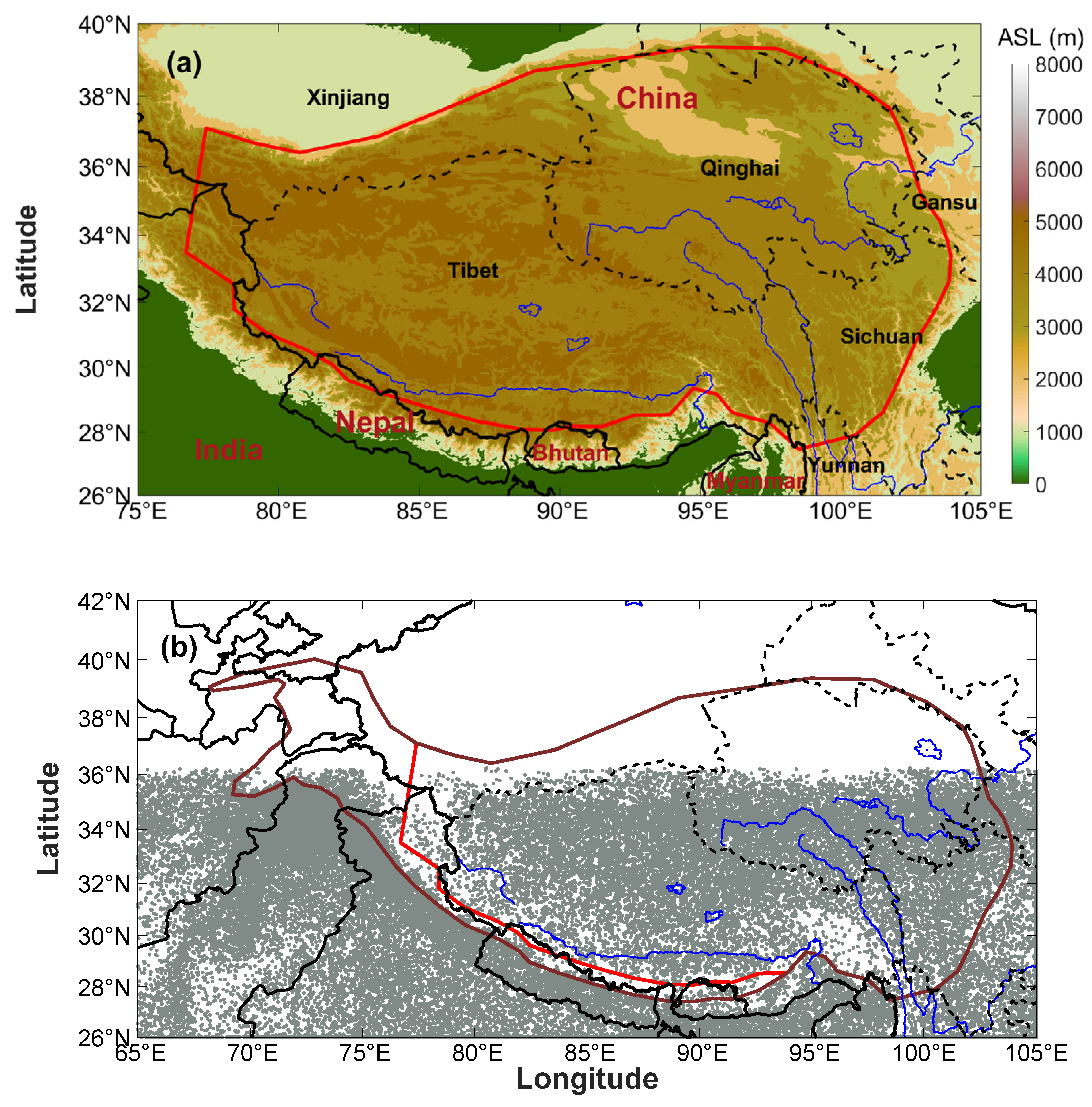
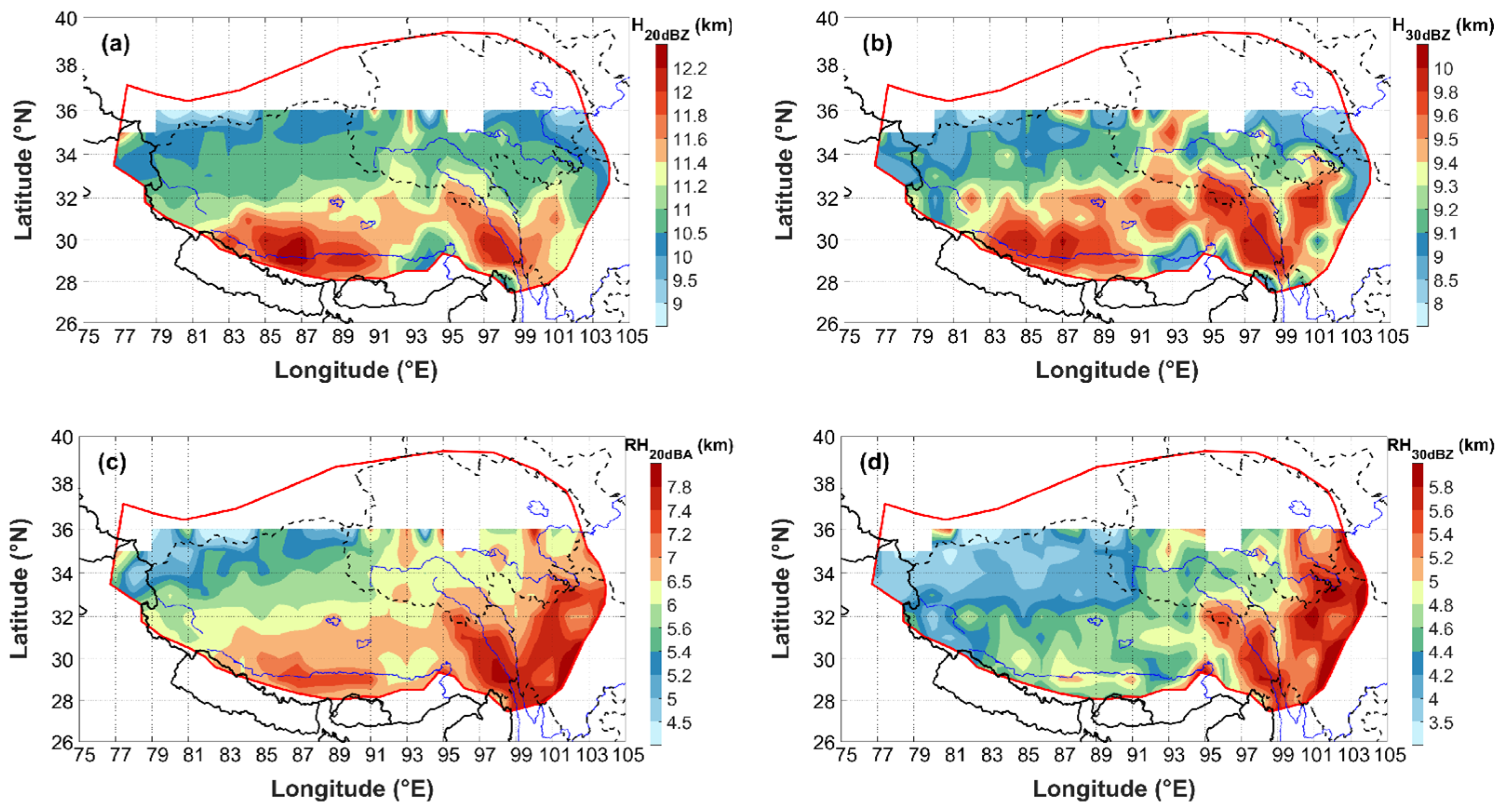

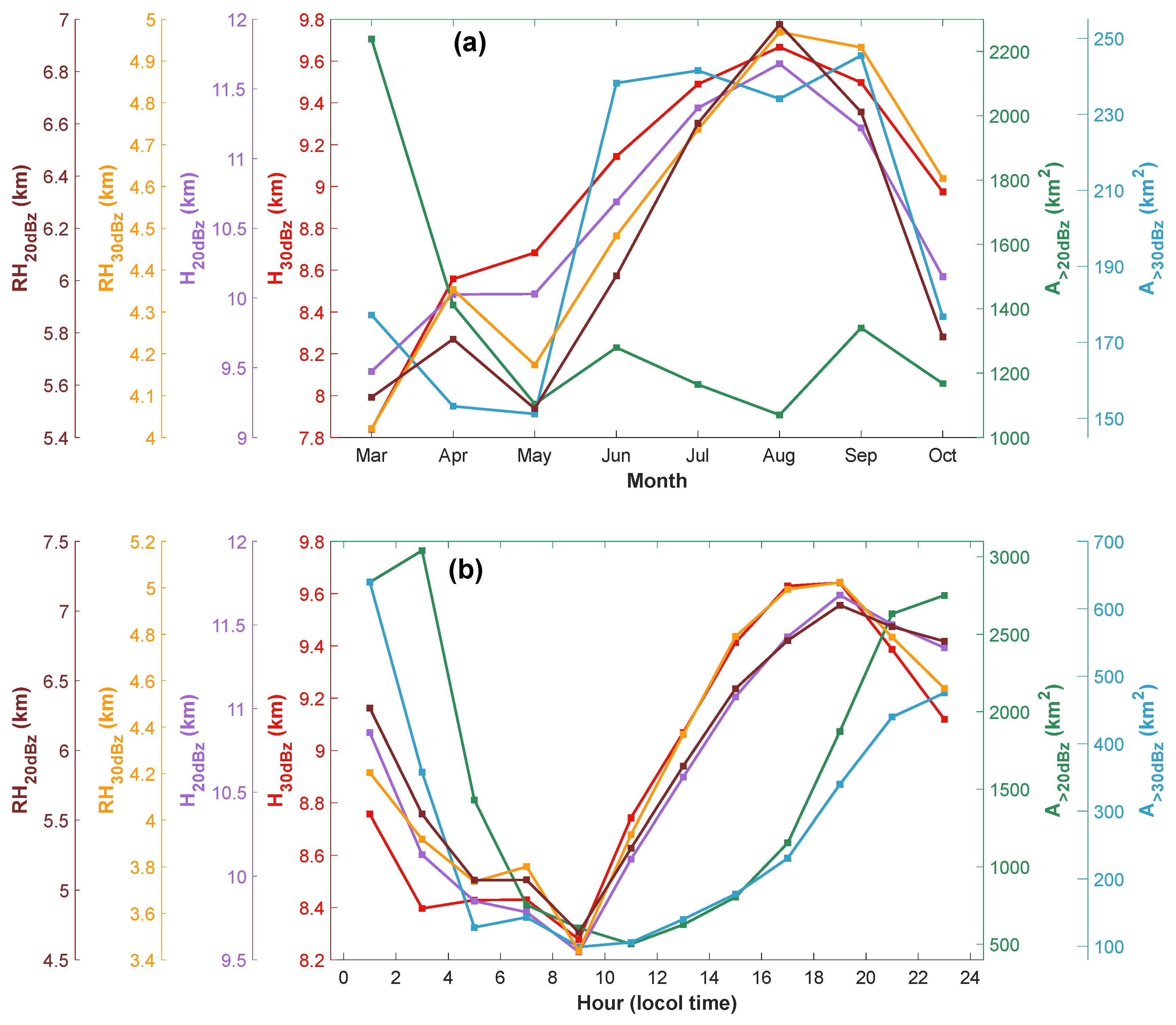
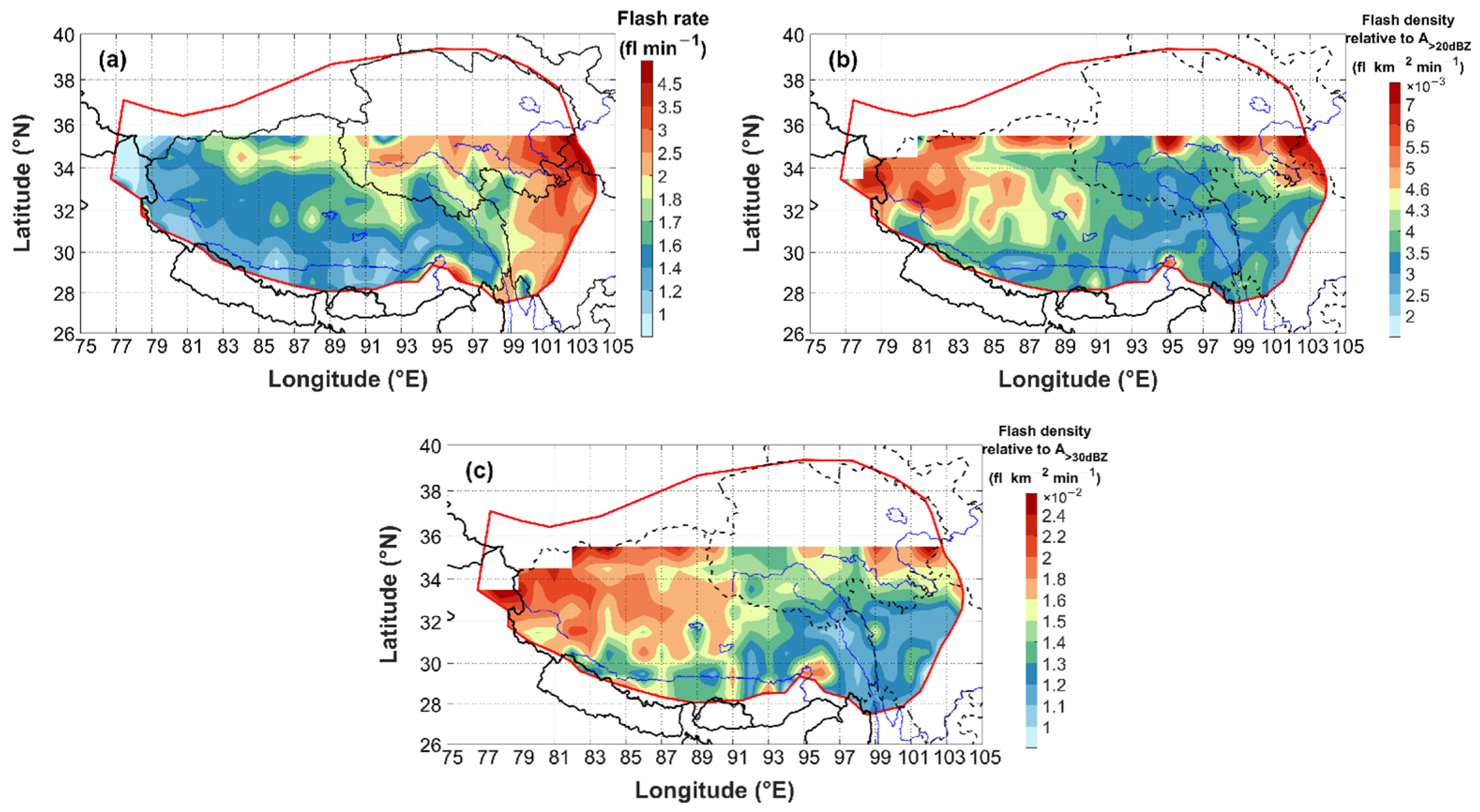
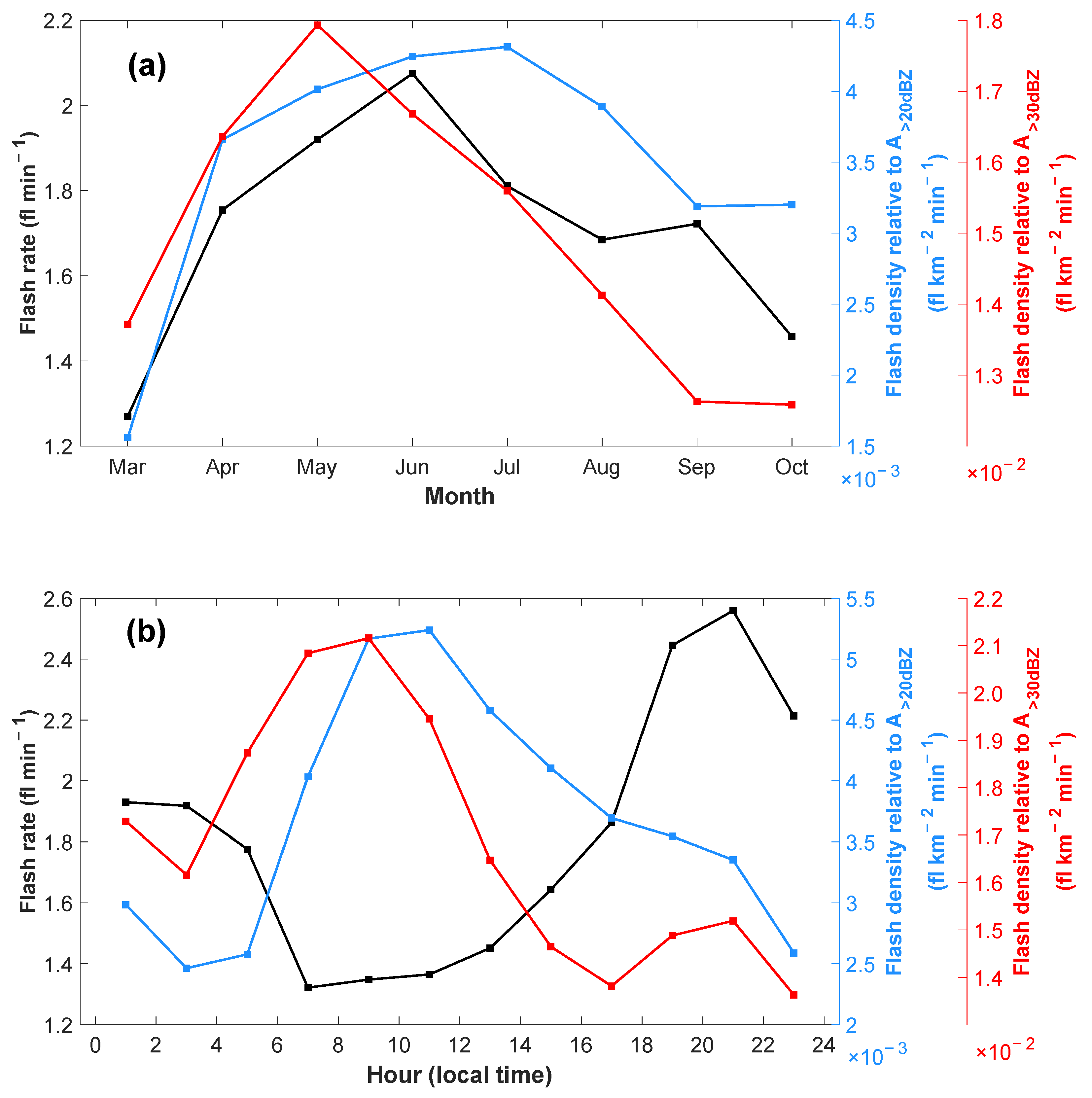
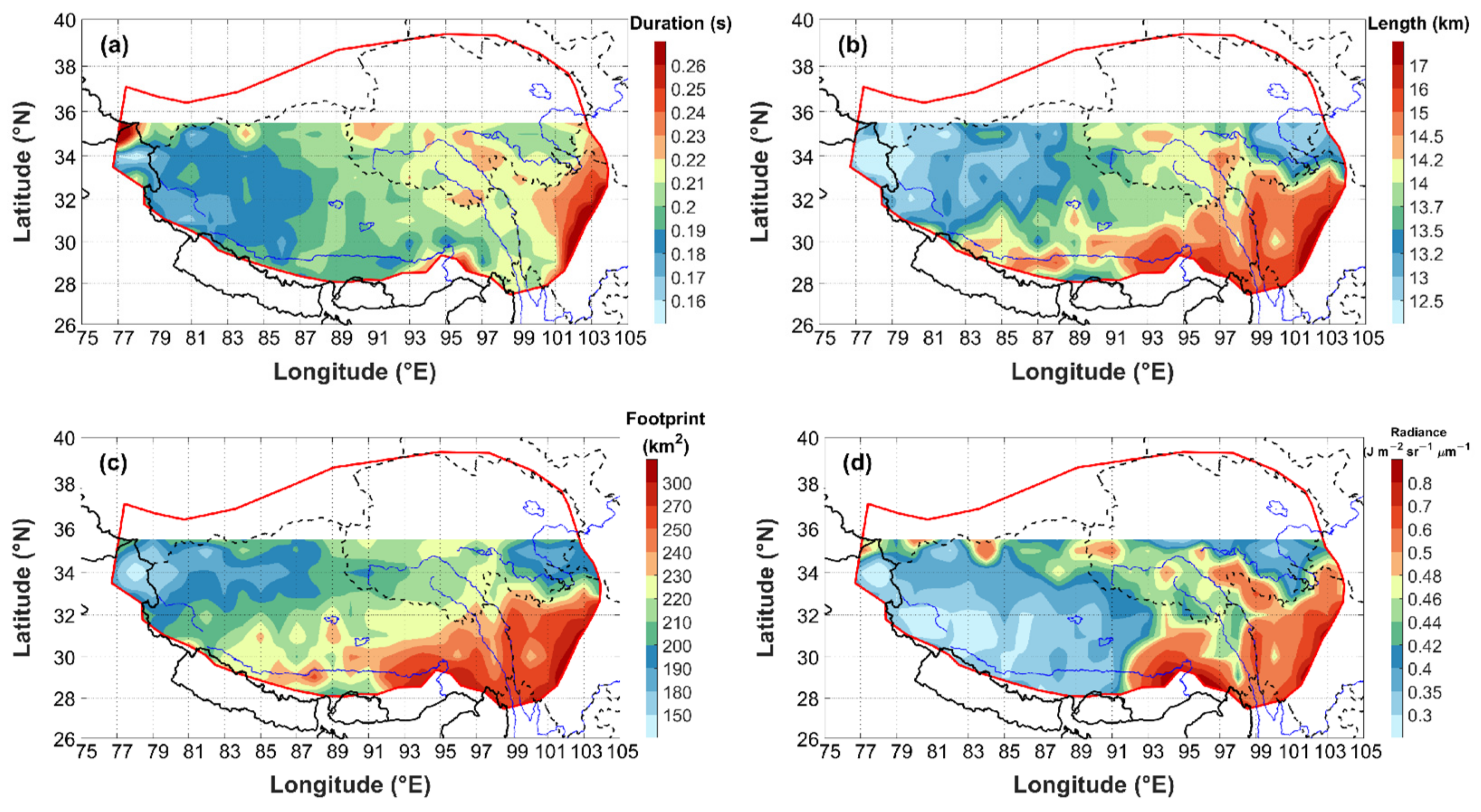
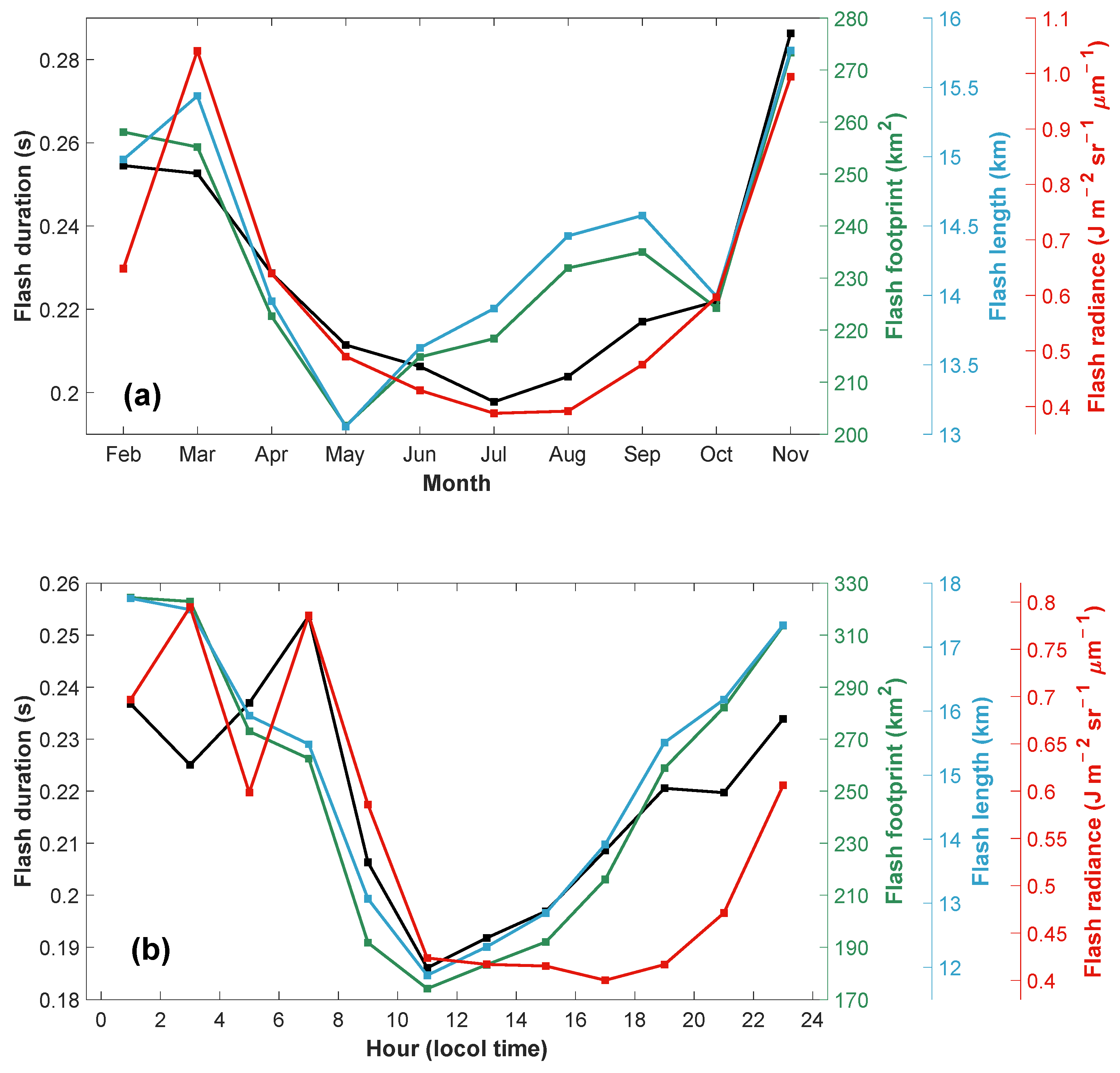
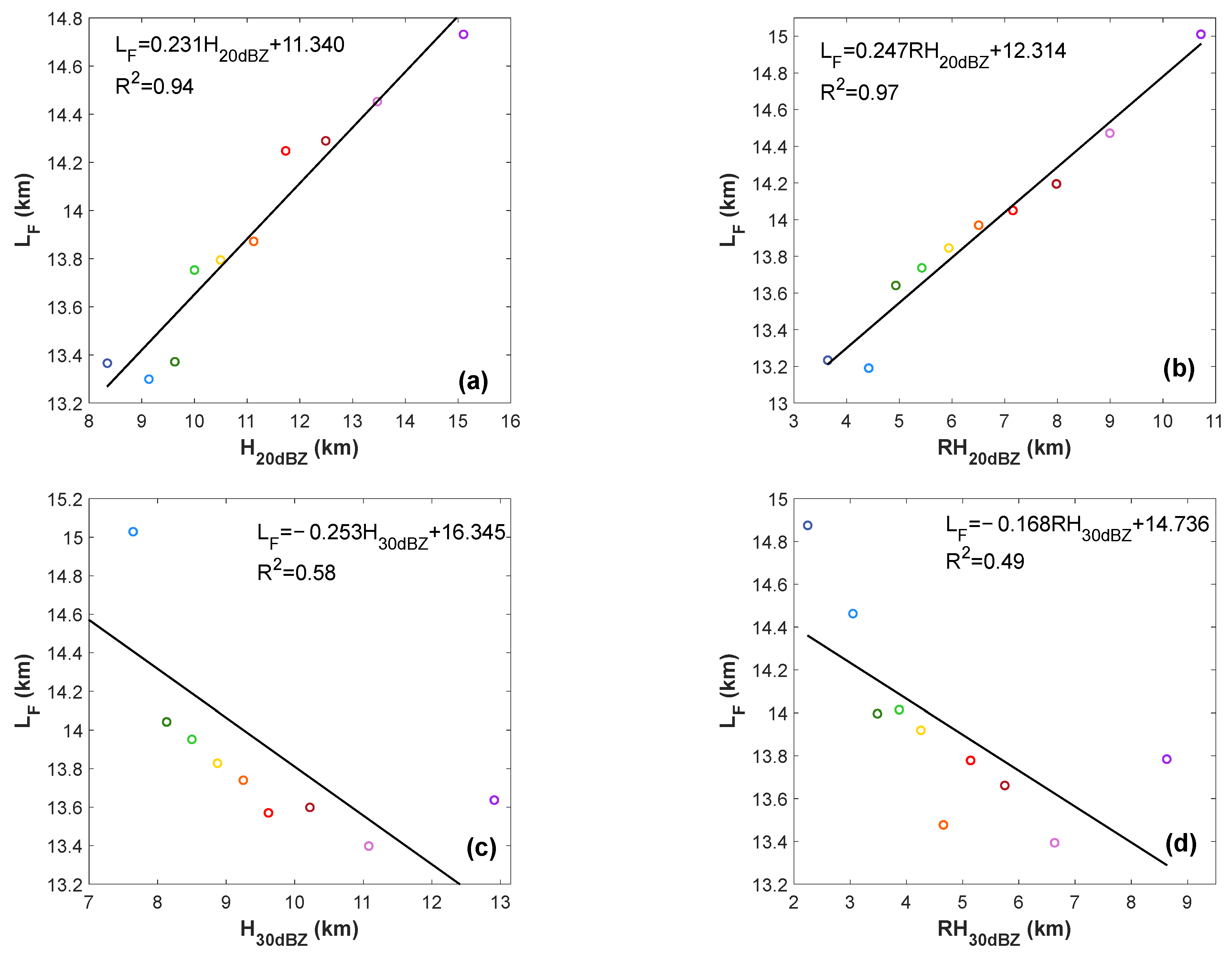
Disclaimer/Publisher’s Note: The statements, opinions and data contained in all publications are solely those of the individual author(s) and contributor(s) and not of MDPI and/or the editor(s). MDPI and/or the editor(s) disclaim responsibility for any injury to people or property resulting from any ideas, methods, instructions or products referred to in the content. |
© 2024 by the authors. Licensee MDPI, Basel, Switzerland. This article is an open access article distributed under the terms and conditions of the Creative Commons Attribution (CC BY) license (https://creativecommons.org/licenses/by/4.0/).
Share and Cite
Du, Y.; Zheng, D.; Zhang, Y.; Yao, W.; Xu, L.; Fang, X. Spatiotemporal Distributions of the Thunderstorm and Lightning Structures over the Qinghai–Tibet Plateau. Remote Sens. 2024, 16, 468. https://doi.org/10.3390/rs16030468
Du Y, Zheng D, Zhang Y, Yao W, Xu L, Fang X. Spatiotemporal Distributions of the Thunderstorm and Lightning Structures over the Qinghai–Tibet Plateau. Remote Sensing. 2024; 16(3):468. https://doi.org/10.3390/rs16030468
Chicago/Turabian StyleDu, Yangxingyi, Dong Zheng, Yijun Zhang, Wen Yao, Liangtao Xu, and Xianggui Fang. 2024. "Spatiotemporal Distributions of the Thunderstorm and Lightning Structures over the Qinghai–Tibet Plateau" Remote Sensing 16, no. 3: 468. https://doi.org/10.3390/rs16030468
APA StyleDu, Y., Zheng, D., Zhang, Y., Yao, W., Xu, L., & Fang, X. (2024). Spatiotemporal Distributions of the Thunderstorm and Lightning Structures over the Qinghai–Tibet Plateau. Remote Sensing, 16(3), 468. https://doi.org/10.3390/rs16030468




